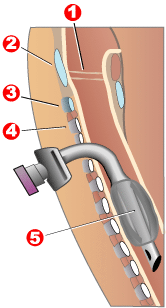Tracheostomy
| Tracheotomy | |
|---|---|
| Intervention | |

Completed tracheotomy:
1 – Vocal folds |
|
| ICD-10-PCS | 0B110F4 |
| ICD-9-CM | 31.1 |
| MeSH | D014140 |
| MedlinePlus | 002955 |
1 – Vocal folds
2 – Thyroid cartilage
3 – Cricoid cartilage
4 – Tracheal rings
Tracheotomy (US /ˌtreɪkiˈɒtəmi/ tray-kee-AW-tə-mee) is a surgical procedure which consists of making an incision on the anterior aspect of the neck and opening a direct airway through an incision in the trachea (windpipe). The resulting stoma (hole), or tracheostomy, can serve independently as an airway or as a site for a tracheostomy tube to be inserted; this tube allows a person to breathe without the use of the nose or mouth. Both surgical and percutaneous techniques are widely used in current surgical practice. It is among the oldest described procedures.
The etymology of the word tracheotomy comes from two Greek words: the root tom- (from Greek τομή) meaning "to cut", and the word trachea (Greek τραχεία). The word tracheostomy, including the root stom- (from Greek στόμα) meaning "mouth," refers to the making of a semi-permanent or permanent opening, and to the opening itself. Some sources offer different definitions of the above terms. Part of the ambiguity is due to the uncertainty of the intended permanence of the stoma at the time it is created.
...
Wikipedia
